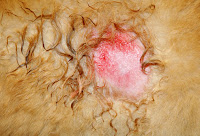We didn't notice it at first because it was right under her neck. She loves to be scratched there. The day after we got home my husband was scratching and felt something hard. We had a quick look but all it really looked like was a scab. Since she's a Golden Retriever her hair is longer and hid the spot well. We didn't investigate further at that point, thinking it was a deer fly or mosquito bite that had bled and scabbed over.
The following day Hubby checked the scab again to make sure it was healing. That's when he pulled the fur away and we saw the oozy pus and sore looking skin. Although we hadn't dealt with a hot spot before as dog owners we knew what they looked like and had encountered other dogs with them. Instead of going to the vets we decided to try and treat it at home, give it a few days and if it didn't clear up, then we'd book an appointment. She didn't seem to be in pain and it didn't bother her if we touched it. It was also in a spot that she couldn't get to, being right under her neck (I'm assuming she got it because I forgot to take their soaking wet collars off the first night we were there so the skin didn't have oxygen to dry). Then because of the bad weather and full access to the lake the area stayed moist for too long.
This is how we treated it:
1) Cut away all hair on the hot spot and surrounding away, cutting as close to the skin as possible. Please be very careful not to nick your pet and have someone help you if your dog is fidgety. You might be astonished to find when you start cutting the hair, just how large the hot spot is.
2) Gently wash the area with a gentle pet shampoo to clean and disinfect.
3) Use a green tea compress on the area to draw out the pus, cleanse and soothe. Green tea has been shown to reduce inflammation and have healing properties. Many people use it for sunburns. To make the compress boil water and make a pot of tea. I put four green tea bags in my tea pot and let it steep for about 15 minutes, making it nice and strong. Put in a container and let it cool in the fridge. Then soak a clean face cloth in the tea and gently apply to the hot spot. I usually held it there for about a minute to make sure it soaked in.
4) Next spray a Benadryl spray on the area. Benadryl spray is great because it helps to reduce itchiness and pain. It's also something vets will recommend both orally and topically so I knew it was safe. At this point I'd leave her alone for about 10 minutes to let everything dry out.
5) Finally we applied a topical hydro-cortisone cream we got at the drugstore. This helped to heal the wound. For the first few days we saw a lot of pus but that's because it needs to draw out the pus before the area can heal. Make sure to cover all areas thoroughly.
We followed steps 3-5 two to three times a day for about 8 days. At first we weren't sure if it was working because of all of the pus we were seeing but Genevieve stopped scratching at it within a day or so of starting the treatment, then the area turned red, scabbed over and it's been just under two weeks and her skin looks great! Now we just need the hair to grow back!
I would like to note that as Genevieve is a Golden Retriever she's a fairly large dog so we weren't worried about the dosages hurting her. Our vet has recommended Benadryl in the past so we knew it was safe and I had been told by someone who's dog frequently gets hot spots that their vet prescribes a hydro-cortisone cream so that was why I picked it up. Most importantly though since it was in a place she couldn't get at, we knew she couldn't ingest the medications. She also wasn't in any pain that we could tell.
If your dog has multiple hot spots and/or seems to be in a lot of pain it may be best to see your vet as I would not recommend anything oral that your vet hasn't prescribed. Since Genevieve wasn't displaying any signs of stress or pain we decided it wasn't crucial to see a vet unless our method didn't work. We saved the cost of a visit and got the same antibiotics we would have from the vet for under $10 at the drug store. Whatever form of treatment you decide on, immediate action is crucial. Hot spots are created by bacteria that can spread rapidly on your pet in a matter of hours. Making sure your pet is on a flea/tick/mite program is also important. Bugs will attack a hot spot worsening the area, preventing treatment from working and can easily cause severe infection and infestation.


No comments:
Post a Comment